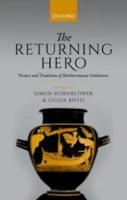
OUP (2018) h/b 354pp £75 (ISBN 9780198811428)
Returning home is sweet, says Homer, with reference, of course, to Odysseus famously striving against all odds to return to Ithaka. But even his eventual restoration to home and family is not unproblematic. As this book points out (p. 86), it takes place at the cost of all the rest of his men losing their own returns and involves the slaughter of most of Ithaka’s population of younger men, thus bringing the island to the brink of a not altogether satisfactorily composed civil war, and hints of further wanderings in store for the hero in Teiresias’ prophecy from the underworld. So what happened to the rest of the Trojan War heroes, and why did even those who returned safely often encounter such difficulties at home as made their return only temporary, or ultimately even untenable?
That is one of the questions this scholarly book sets out to answer. It contains an introduction followed by a collection of eleven papers arising from a conference entitled ‘Nostoi’ held in Oxford in May 2016 and dedicated to the memory of Martin West. The chapters are organised thematically in chronological order, with numerous black and white illustrations and maps as well as a detailed bibliography and indices. In spite of its aim to be accessible to non-specialist readers with the relegation of all ancient Greek to the footnotes, this is a densely argued book suited only to an academic audience.
The ‘returns’ explored are chiefly of the mythical heroes from Troy and the way in which the Greeks personalised colonisation and immigration through the cult of the oikist hero. The topic is presented through the different viewpoints of scholars specialising in history, literature, myth, and archaeology (p. 4) using literary texts ranging from the epic cycles of Trojan War nostoi to Lykophron’s Alexandra, as well as material evidence and modern network theories.
The development of nostoi myths during the late 8th-7th centuries BC reflect the great changes attendant on the dissolution of Bronze Age Greece and the resultant migrations, leading to the emergence of ethnicity and new political orders focused around the polis. The alternative versions of Odysseus’ return hinted at by Homer in some of the hero’s own traveller’s tales set in Egypt and Crete illustrate that the greater focus in The Odyssey on adventures set in the northern and western Mediterranean reflects contemporary focus on exploration of this area.
Subsequent chapters deal with the epigraphic evidence for the ‘right of return’ to the mother city for Greeks going out to settle overseas, or during the period of colonising expansion; the nostoi of Philoktetes and Epeios as evidence for peaceful cultural interaction between Greeks and native peoples in Southern Italy; and the role of women, who provide reasons for, or act as goals of, male nostoi by preventing or delaying their return home, or represent dangerous booty, but rarely achieve their own nostoi because, in accordance with the historical behaviour of their sex, they were expected to travel as little as possible.
Further studies focus on how Greek tragedy, especially the story of Iphigeneia, demonstrates that a period away from home and consequent nostos is a way of constructing the individual’s identity in relation to home, family and community; and how almost all tragedies, as well as many comedies, involve some form of nostos, exploring associations between people and places and ‘repackaging issues of group identity in the form of personal emotional experience in embodied space’ (p. 192).
Later chapters focus on the late-coming Macedonian aristocracy of the Argeadai marketing themselves as Argeioi (Argives) and re-playing the Trojan War, as well as relocating adventures of mythical heroes like Perseus, Herakles and Jason to lands conquered by themselves. Alexander is shown as regarding his arrival in India as a nostos in the footsteps of Dionysos and Herakles, while the discovery of Armenians as being descended from the Thessalian hero who was Jason’s companion on the Argo is seen as a way of making a new environment familiar to incoming strangers. There are four case studies of nostoi used by communities to shape their own identity in relation to their neighbours, and one about the failed nostos of Kalchas the seer, who died and was buried at Kolophon. This becomes more appealing when the city emerges from a period of instability and seeks to forge a new civic identity in a world where the rise of Roman power makes it desirable to promote a myth about the defeat of an important Greek to win political favour from a similarly anti-Greek foundation.
The collection ends with a very thought-provoking chapter extending into the Roman era itself on possible negative connotations of the ideas of house and home, and of the Mediterranean as a place of constant, regular displacements of people like traders, seasonal workers, mercenaries, colonisers, soldiers departing for war, athletes for Pan-Hellenic games, exiles, religious pilgrims to sanctuaries and even brides to their new husbands’ homes. For slaves also there can be no nostos in the sense of returning to their former homes. But as a counterbalance to this, during the Roman Empire, where in big cities there develops a large population with no idea of their parents’ patria, slaves can be set free, or conquered peoples absorbed into the empire and given a new identity or citizenship and homeland.
This volume offers a range of interesting ideas on the theme of nostos, chiefly by pointing out how difficult it is to return home after absence, when neither the returner nor the home is the same.
Claire Gruzelier
